Even in a transitional period, at least by their lofty standards, Spain enters Euro 2024 as one of the favourites.
Featuring a blend of players in their final years with the squad, a strong presence of La Liga’s peak-aged players, and exciting youngsters, this Spanish team may not be the dominant presence it once was, but this is still a squad with high expectations and the talent to deliver a memorable tournament.
Perhaps the most exciting aspect of the Spanish team is the injection of young talents.
Nico Williams and Lamine Yamal have brought life to the squad.
With their possession-dominant, positional play game model, these two electric wingers have the creativity and dynamism that Spain has lacked in recent years.
This tactical analysis and Spain scout report will take a look at Spain’s tactics, as well as our projected squad.
Spain’s road to the top is a difficult one, landing in the Group of Death with Croatia and Italy, but you can never count out the Iberian powerhouse.
La Furia Roja will make their presence felt.
Spain starting XI
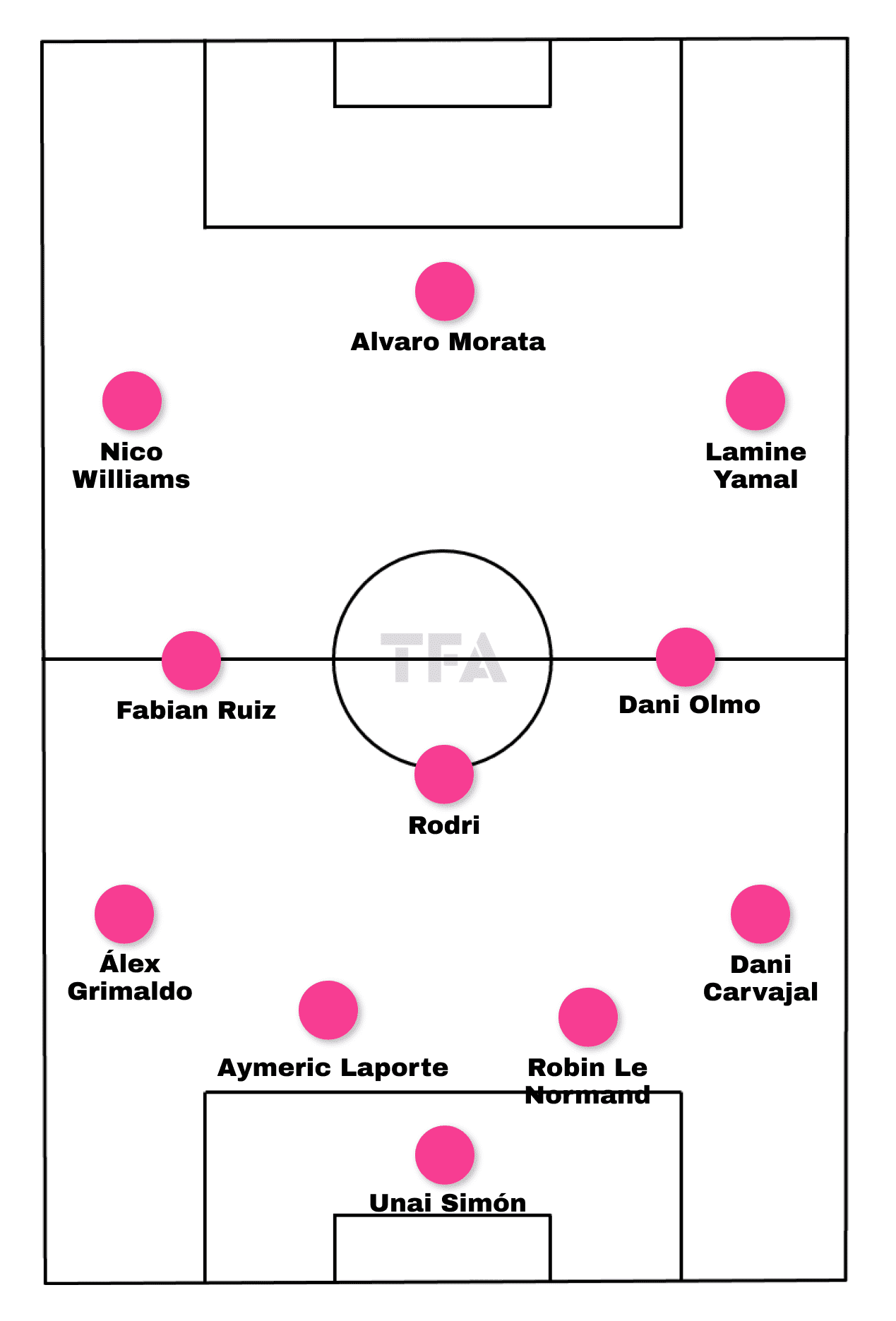
Let’s start with the starting XI.
Likely to play in a 4-3-3, look for Unai Simón to play in goal with Aymeric Laporte and Robin Le Normand in front of him, though we could see Pau Cubarsí make a push for minutes.
Dani Carvajal is a lock on that right side, but there is a bit of a question mark on the left.
Bayer Leverkusen’s Álex Grimaldo gets our nod for the incredible season he has had with the invincible Bundesliga Champions.
Manchester City’s Rodri is the focal point of the Spanish midfield and will likely see Fabián Ruiz and Dani Olmo in front of him.
Up top, look for Álvaro Morata to get the nod at the #9.
It’s the wings that offer the most excitement within this Spanish squad.
Nico Williams is a virtual lock on the left side and is one of the most exciting young players who will feature at Euro 2024.
On the right-hand side, Barcelona’s teenage sensation Lamine Yamal should see the majority of minutes.
Expect some degree of rotation on the right, given Lamine Yamal’s age and the physical load he took on in La Liga, but it’s the teenager that gives Spain the greatest edge on the right side.
As mentioned, the squad offers a nice blend of experienced players on the other side of 30 who are still performing at a high level and peak-aged La Liga talent.
They’re supported by three youngsters, Williams, Cubarsí and Lamine Yamal.
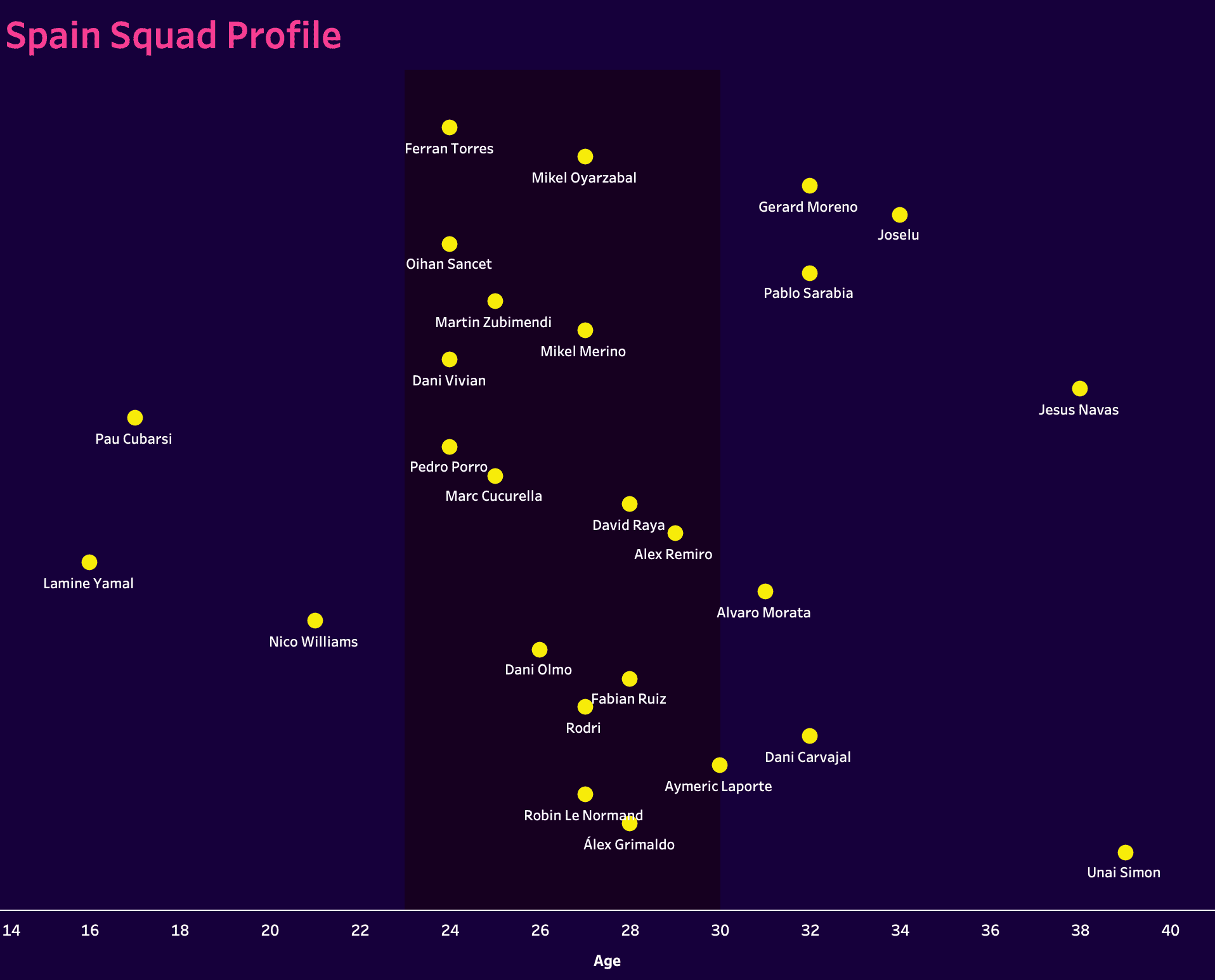
In terms of squad composition, the side is heavily domestic.
That common understanding has often given Spain an advantage in international play.
Though this squad is light on players from the Big Three in La Liga, at least lighter than normal, there is still some exceptional talent that has continuously gelled during international windows.
Attacking phase
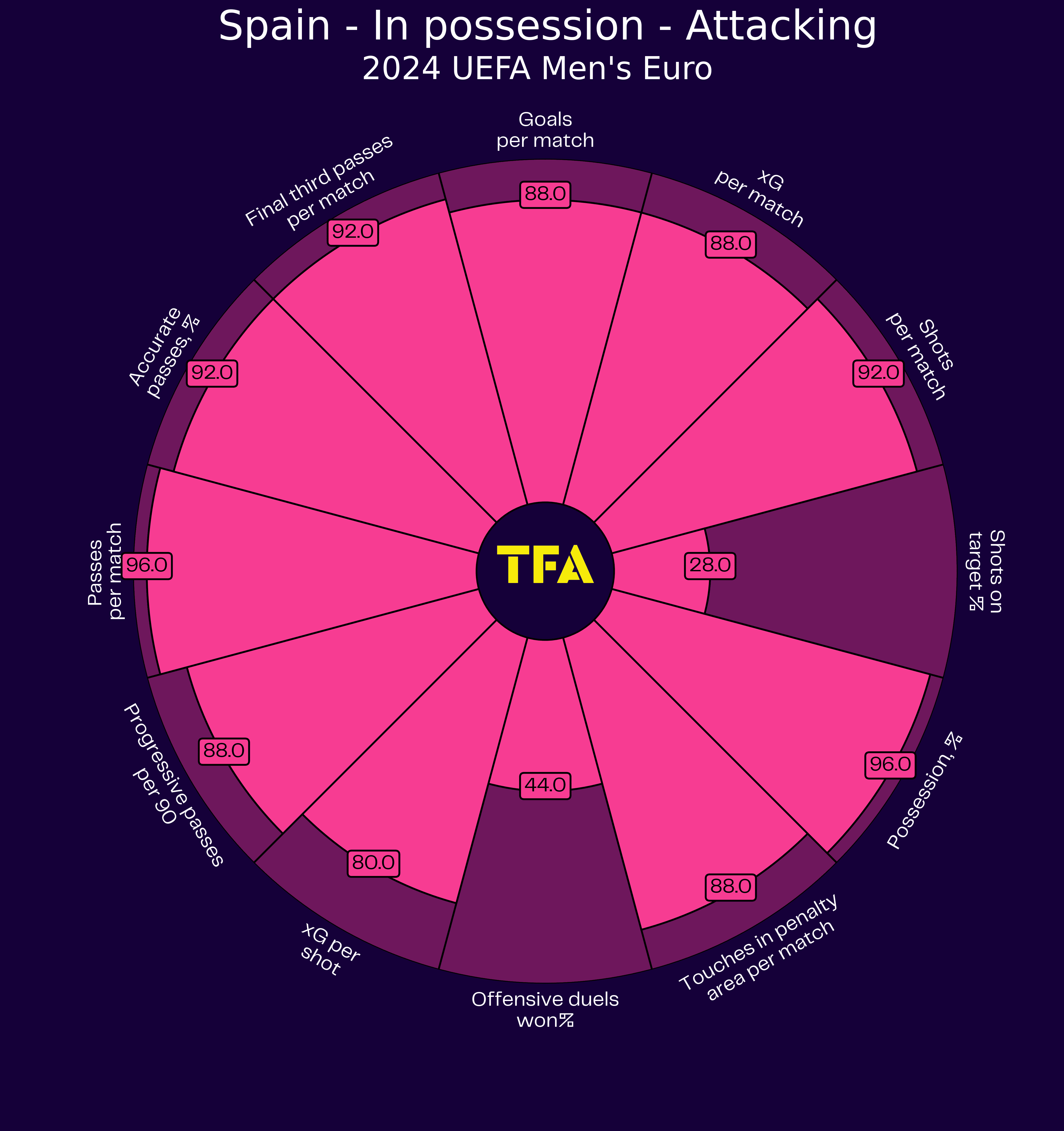
There’s very little not to like with Spain’s attacking data.
The statistics represent a full calendar year of matches.
One of the few poor areas on the chart, offensive duels won percentage, is likely improved by the more recent presence of Lamine Yamal and a more consistent workload from Nico Williams.
Shots on target are the only other clear weakness, but the other statistics range from very good to phenomenal.
At the heart of Spain’s attacking tactics is their hallmark of possession dominance.
They will look to dictate the terms of play through possession, ranking in the 96 percentile in the past year.
It’s both a means of attacking and a way of limiting the opponent’s ability to influence the game while on the ball.
Look for Spain to use possession to pin opponents deep in their end while trying to cut off their opportunities to get outside of Spain’s attacking shape.
Of course, such an approach has difficulties, but we’ll get to that shortly.
Turning to Spain’s build-out, they can use a variety of methods to break down the opposition.
Whether it’s wide overloads to unbalance the opposition and switch the point of attack or getting your opponent to over-commit on the vertical axis to then attack space between the lines, the Spanish side will lean on the build-out to initiate the attack.
They’re perhaps at their best when opponents push too many numbers high up the pitch.
That does put an extra emphasis on the centrebacks and goalkeeper, which does not perfectly suit Simón, but when Spain gets it right, they can create more direct attacks once they play beyond the opponent’s first two lines, as they did here against Norway.
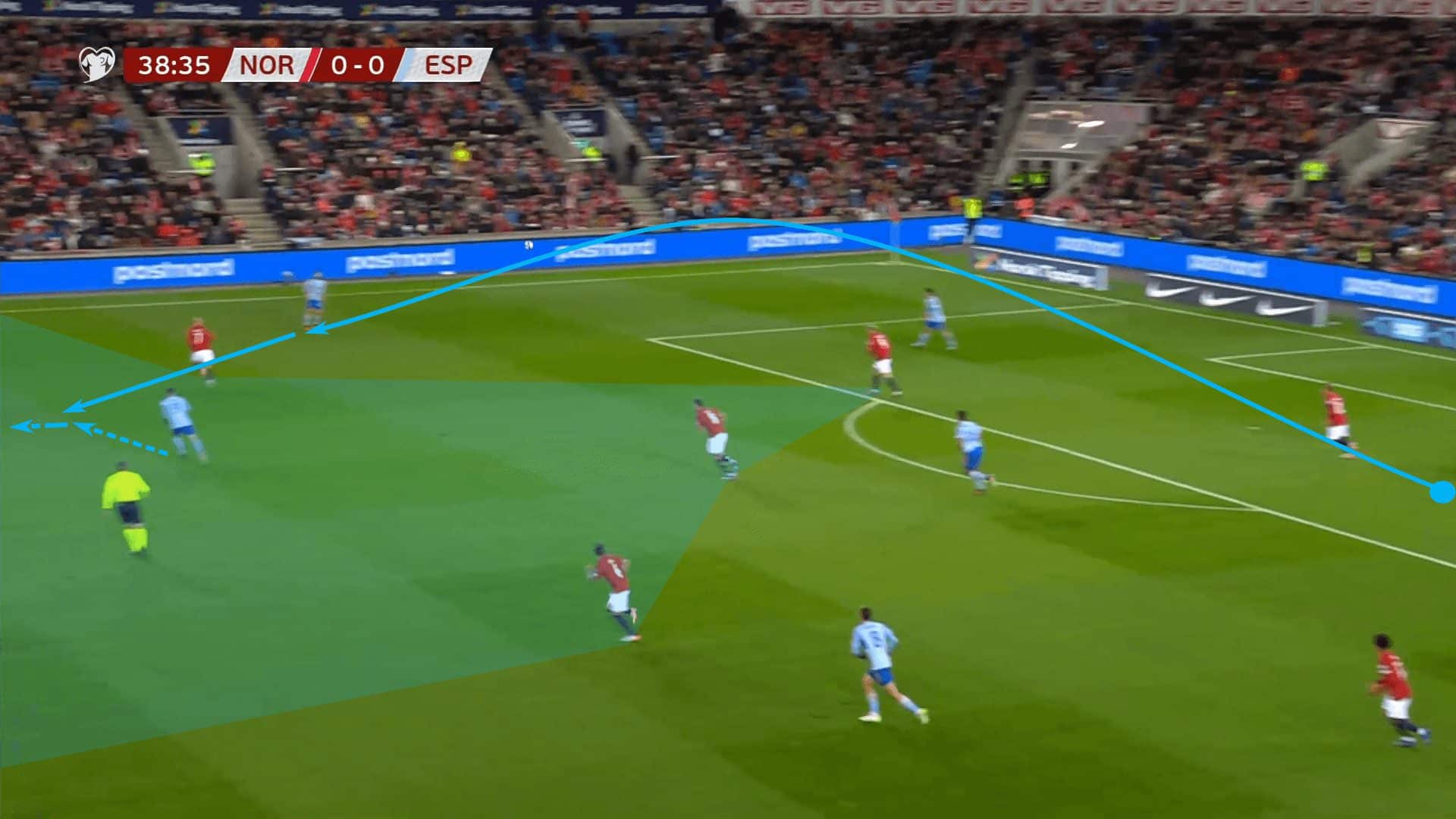
As they get to the middle third of the pitch, this is where a combination of ball-near overloads and high central presences can compact the opposition’s defence to create attacking opportunities elsewhere.
In this second tactical image, Spain commits five players near the ball, drawing seven Norwegians to that area.
That leaves a gap for the pass into the left wing and progression into the box.
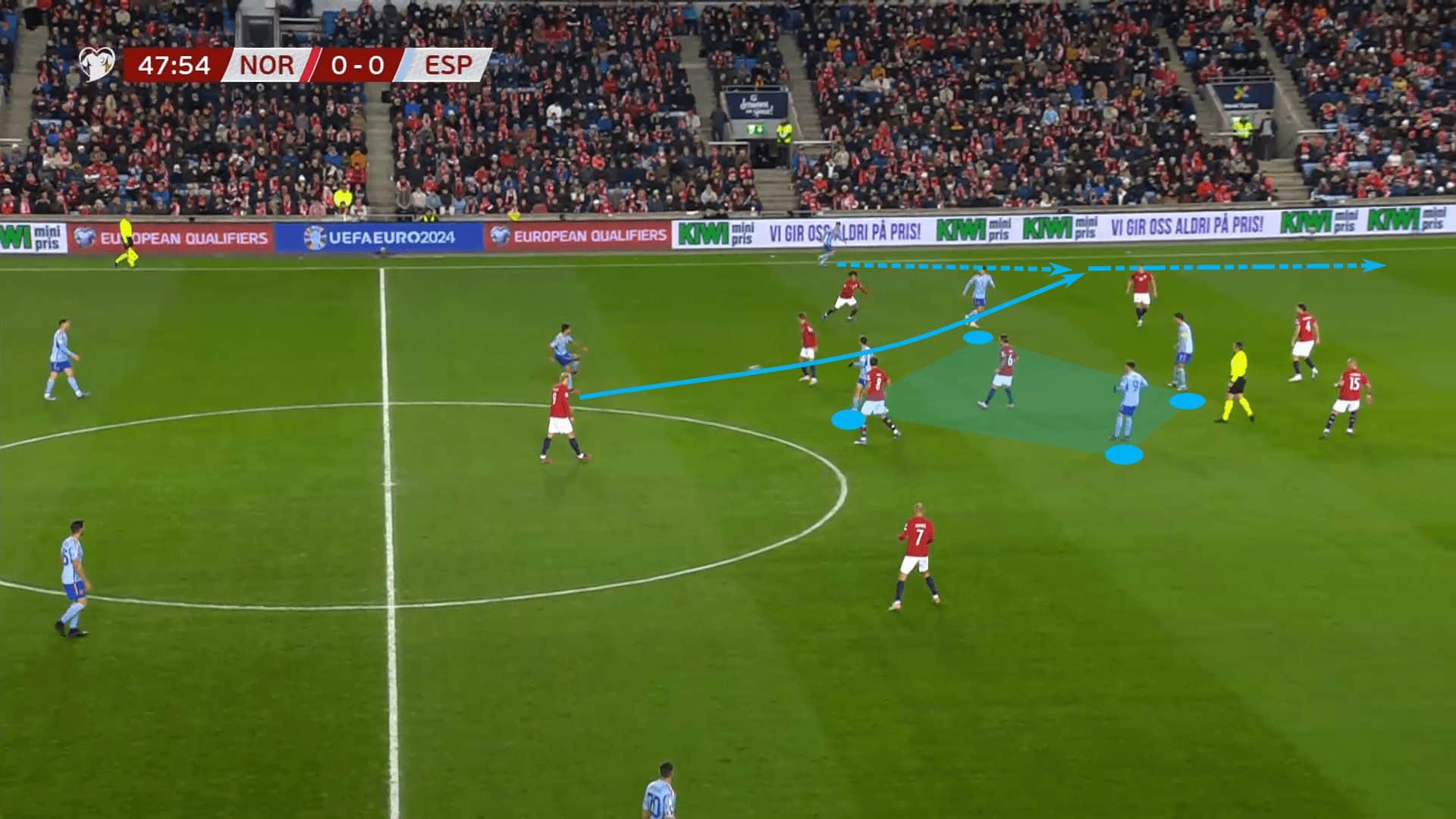
When it’s the high central presence that they lean on, what Spain is really trying to do is create space between the lines.
Then, when the opposition becomes stretched, look for one of Spain’s high central players to drop between the lines.
The intention is to receive on the half-turn and run at the backline, as seen here.
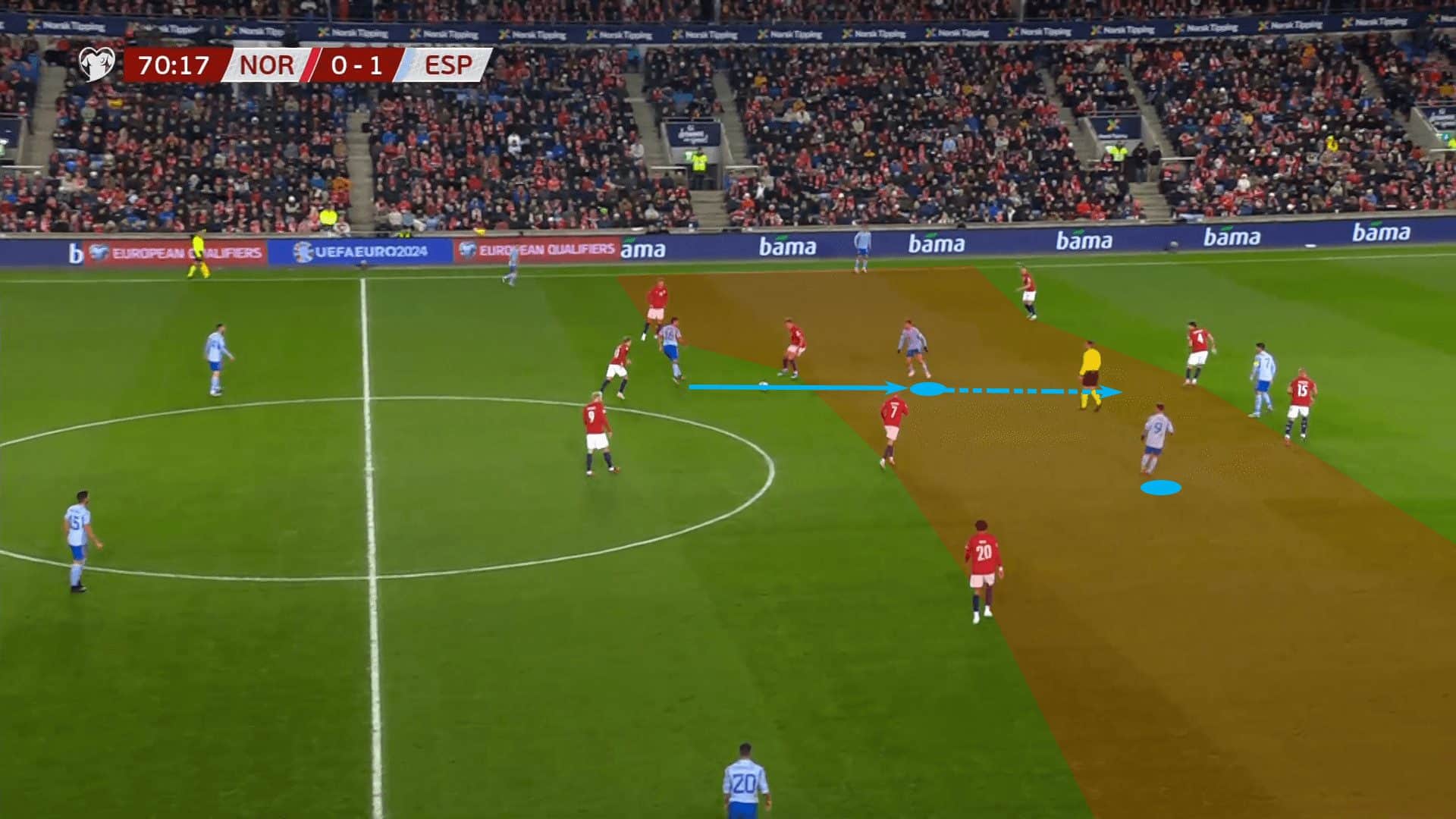
As they move into the final third, part of their success is based on the dynamic 1v1 ability of Williams and Lamine Yamal.
If they can beat their opponent in the wings, the Spanish will trust them with isolation to offer runners into the box.
When faced with a low block, Spain will also look to overload on one side, presenting a threat to enter the box on that part of the pitch.
If the opponent doesn’t commit, they’ll look to progress through that side.
In all likelihood, they will get the response they anticipate with the opponent bringing additional numbers.
As the opponent becomes unbalanced near the ball, expect Spain to switch the point of attack.
In this fourth tactical image, we see the players in the shaded area who created the initial overload before switching the point of attack.
Once play is switched, it’s those players who will move into the box and offer targets in the box.
In this example, the sequence resulted in a goal.
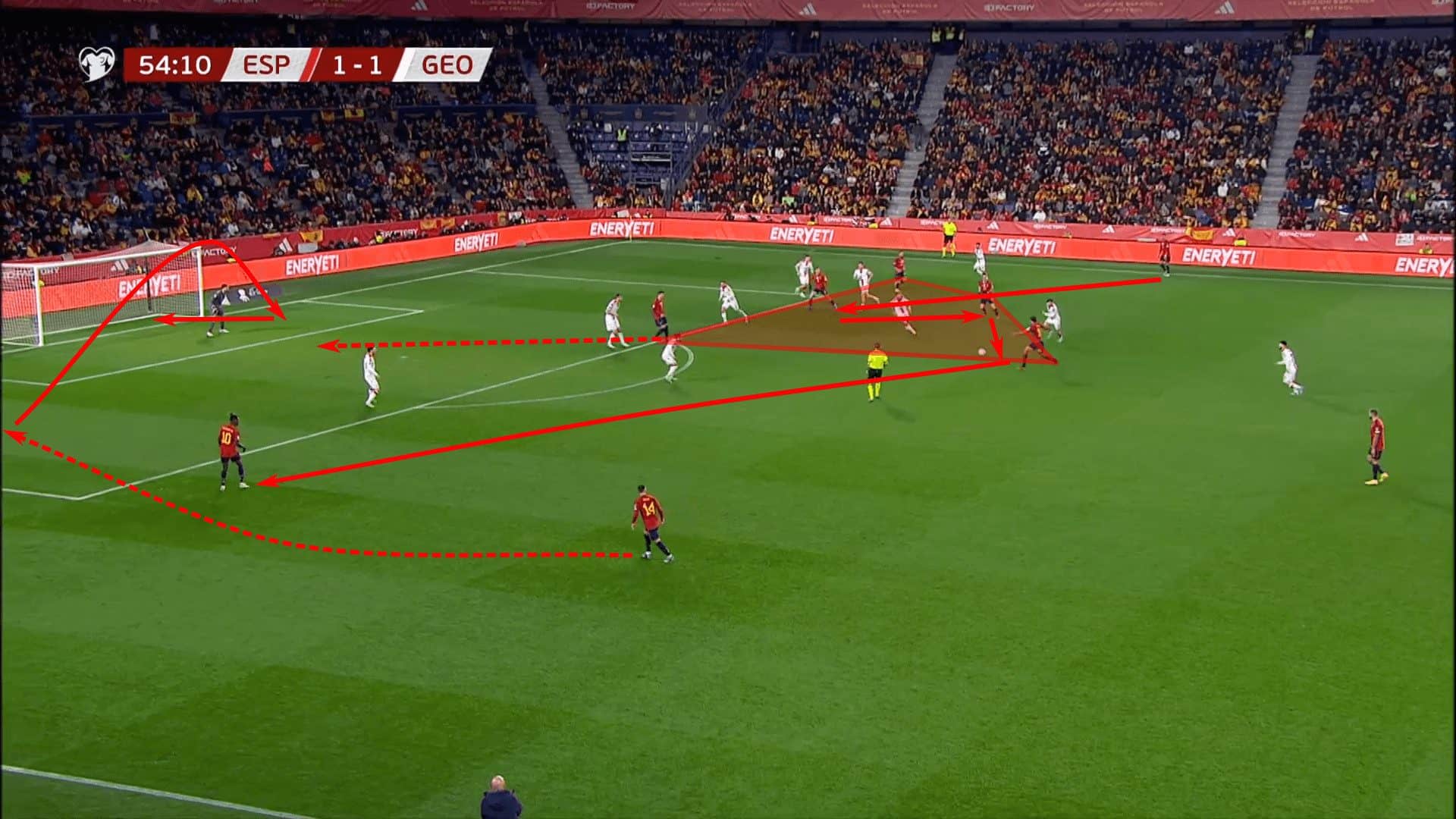
One obstacle that Spain’s style produces is the need to beat low blocks.
Their possession dominance allows teams to drop numbers behind the ball and defend with 9 to 11 players in their defensive third.
Historically, when Spain suffers at international tournaments, it’s against an opponent that has suffocated their attacks by blocking entry into the box.
A setup similar to Norway’s in our last attacking image is fairly common.
One important note here is that not only has Norway dropped nine players behind the ball, but Spain has committed eight players into the final 25 yards of the pitch.
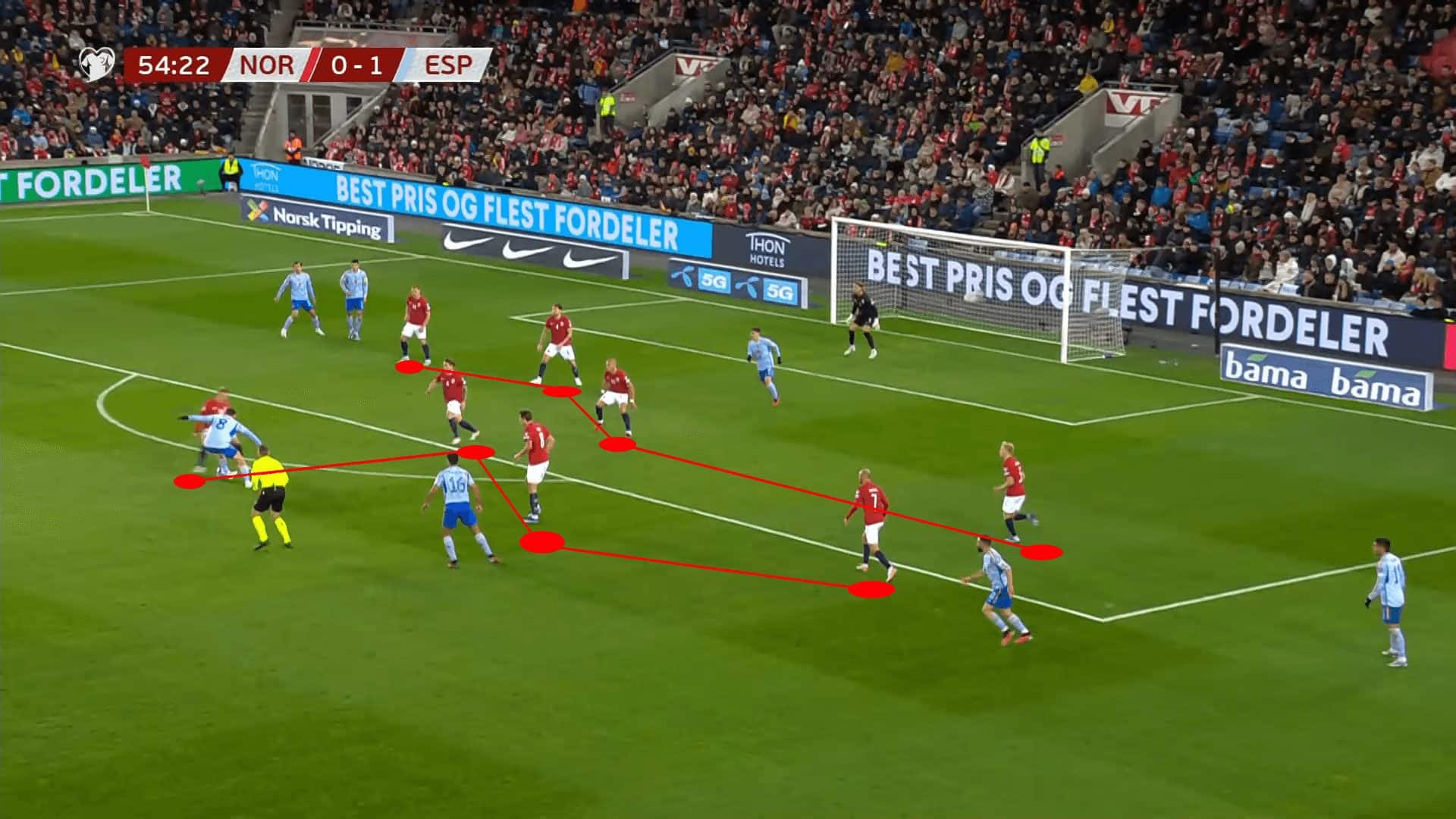
When the Spanish do get in trouble, it’s the numbers that they push forward that leave them exposed.
The catch-22 here is that they need the numbers to beat the low block and often have success doing so, but when they don’t, the chances they give up a goal are often very dangerous.
Defensive phase
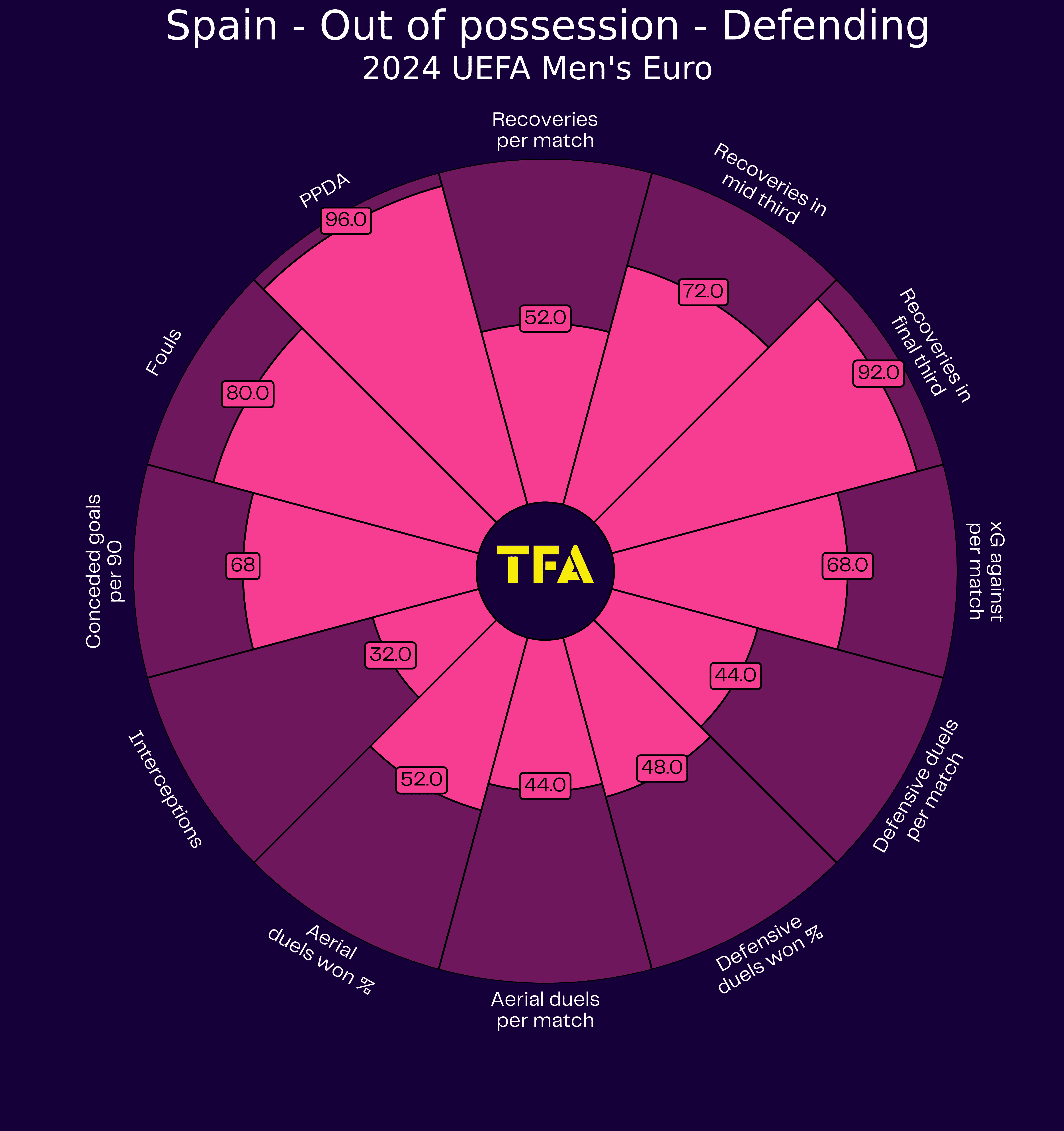
Looking at Spain’s defensive wheel, the data shows that they are in the 96th percentile in PPDA and recoveries in the final third.
Sounds great, doesn’t it?
On further analysis, their conceded goals, P90, and xG against per match show the crack in the armour.
While the 68th percentile is not terrible, it’s certainly not a place a tournament favourite would want to land in.
This Spanish team has areas of vulnerability, and it’s primarily due to its defensive tactics.
Jumping right into it, it must be said that Spain’s high press is not the issue.
In fact, it may very well be the best high press of the tournament.
Even the likes of Brazil found it extremely difficult to reach midfield when the Spaniards were organised high up the pitch.
Breaking their tactics down through in-game images, we can see that the #9’s job is to cut the field early.
He must funnel play to one side.
Notice that the #7 and #11 start deeper and await their opportunity to pressure a centreback.
In midfield, Spain starts with a man-marking approach before releasing the player on the far side of the ball, Rodri in this case.
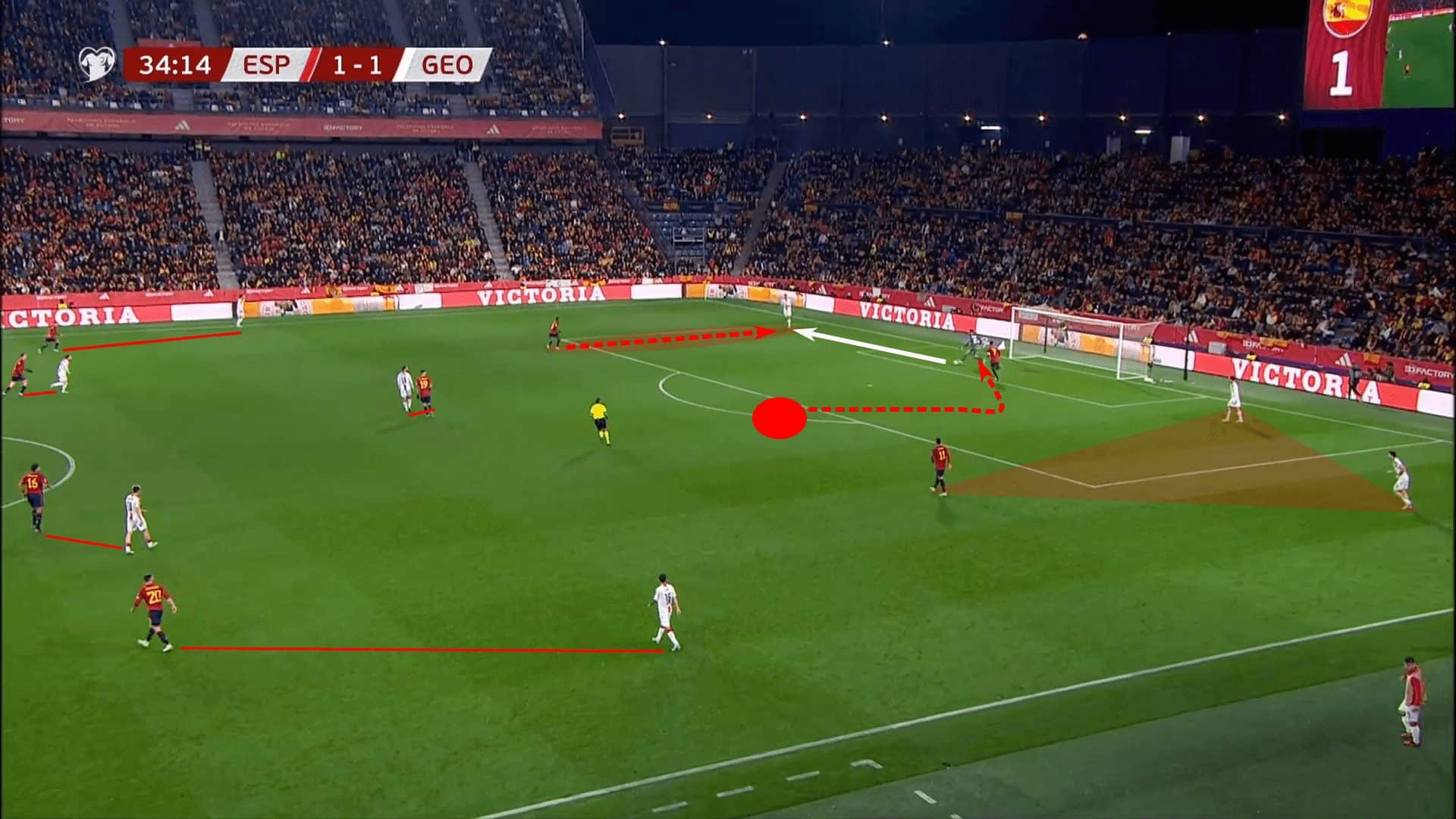
Once the ball does go wide, Spain does well to seal play and force hopeful balls forward.
This is where the high recoveries come in.
It’s very difficult to play through their press.
It’s highly organised and greatly limits the opposition’s ability to play out.
With so few options available, most opponents end up turning the ball over, just as Georgia did in this game.
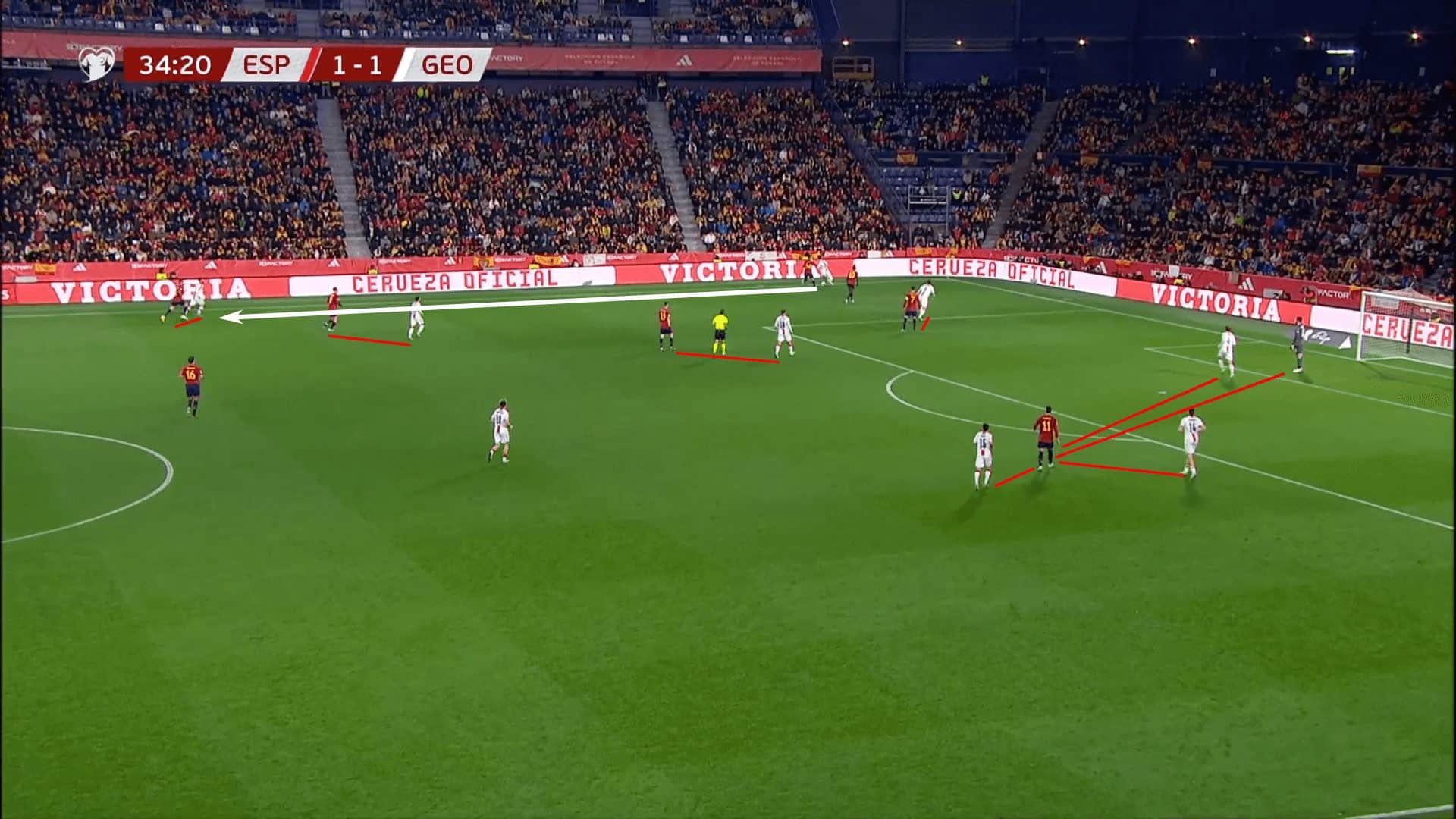
It’s their defensive efforts elsewhere that caused them issues.
For example, when they set up in a mid-block against Brazil, members of the backline were quick to follow opponents as they dropped to the midfield, leaving significant gaps along the backline.
The shaded areas represent lanes that teams would look to exploit from the wings or even midfield.
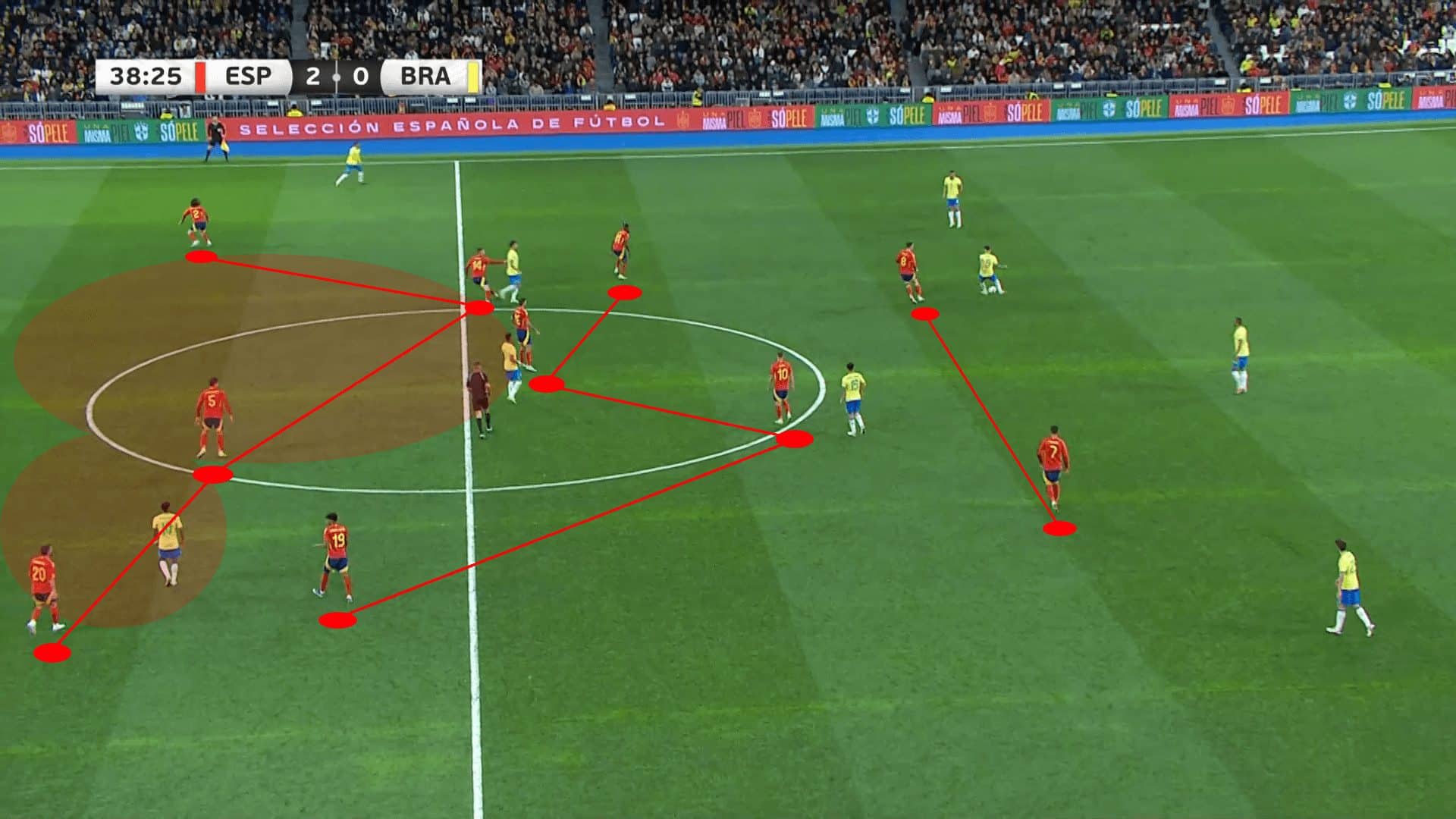
That central area is one that they have struggled to manage.
Shortly after pulling ahead against Georgia, the Euro debutants equalised with a simple through ball into the central channel: one touch and a goal.
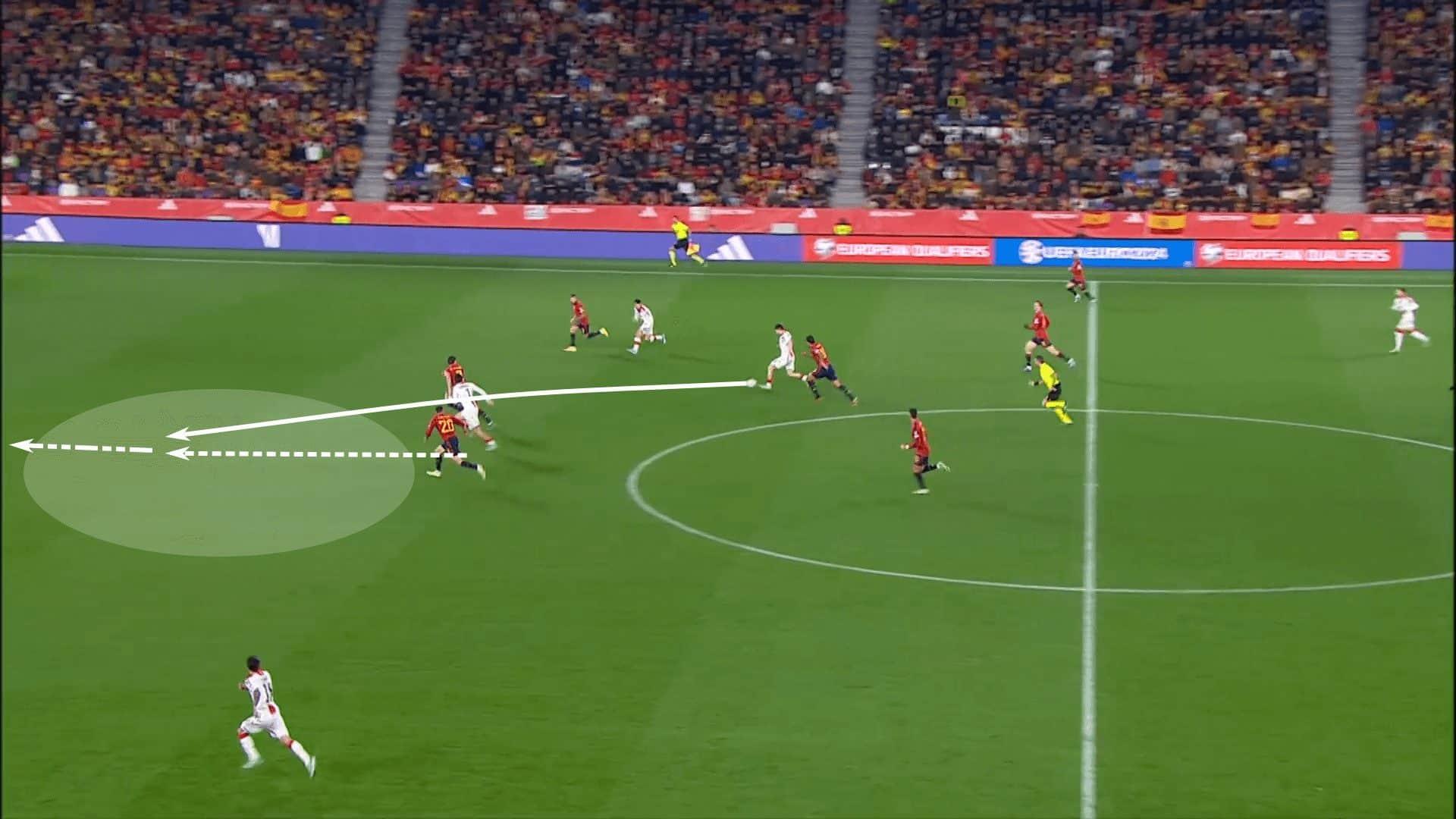
Spain’s defensive success will largely be replicated by the efforts of the high press.
It’s a formidable one, especially from dead balls and moments in which each team has a chance to organise.
Even the world’s best struggle to play through that high press, which could be a similar story in this tournament.
The main area for concern is their other defensive efforts.
When that high press doesn’t work or when they’re pushed into a mid-block, that’s when issues arise.
It’s certainly an area to observe as the tournament progresses.
Transitions
Transitions are an interesting topic for the Spanish team.
They’ve certainly improved in this area with their young wingers on the pitch, but by our analysis, it’s a hit-or-miss phase for the team, both in terms of the attacking and defensive aspects.
Starting with the attack transitions, Spain’s comfort level with their in-possession tactics can lead them to quickly abandon counterattacking opportunities.
There are certainly moments, especially against lesser teams, where they were equally at ease abandoning counterattacking opportunities and settling into a structured possession.
When they do look to take their chance, that first fall into the highest line, especially the two wingers, is critical to their progression.
In this first example, it’s Real Sociedad’s Mikel Oyarzabal who gets into the 3-5 gap and drives into the opponent’s box.
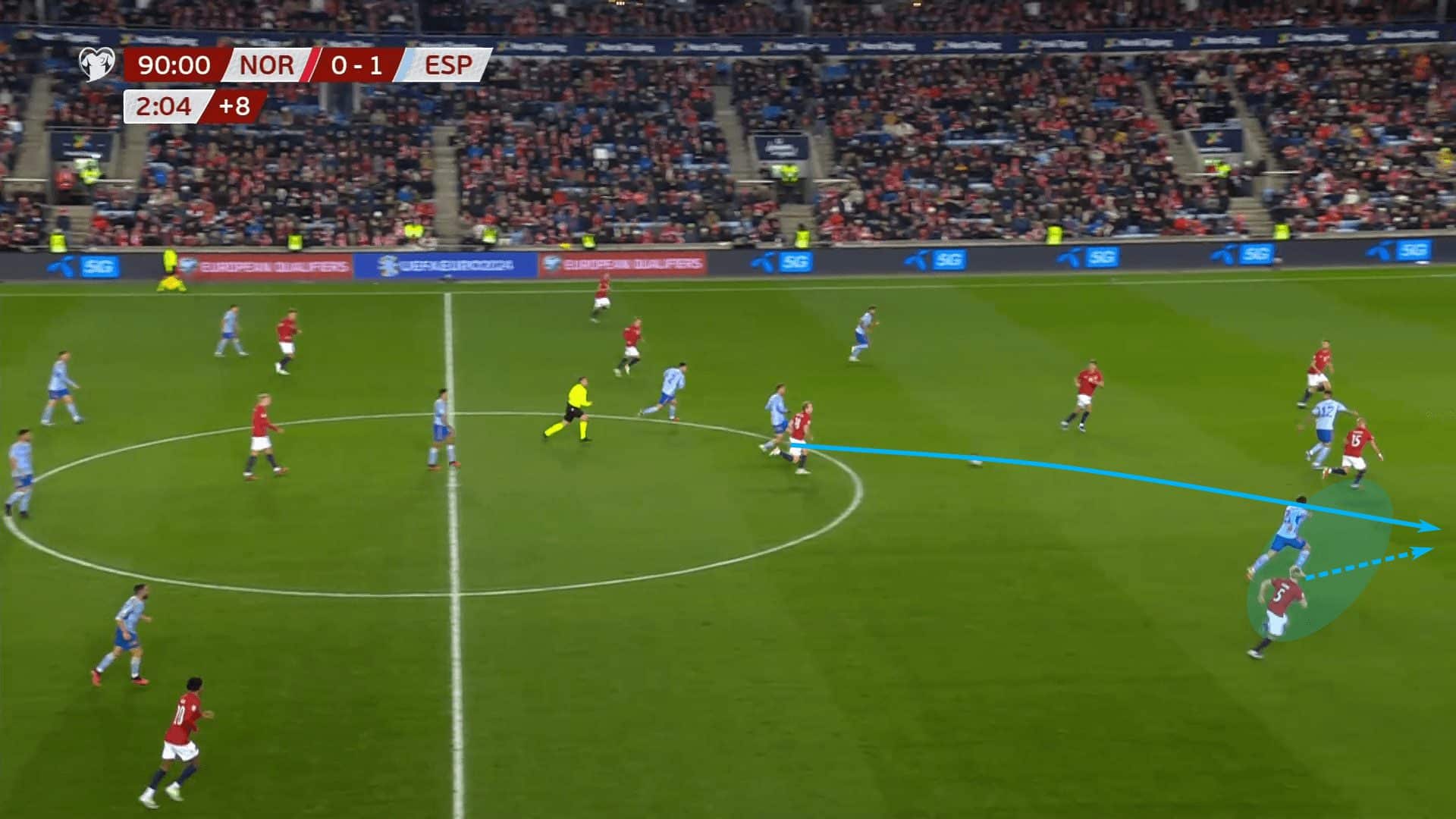
Against Brazil, Spain was more likely to play into that forward line and look for scoring opportunities before the South American side could get numbers behind the ball.
Could a similar trend continue at the Euros, settling for structured possessions against lesser opponents and looking for opportunities for quick progression in the later stages of the tournament? That’s certainly a topic to monitor.
Defensively, we’ve already noted that Spain is one of the most aggressive counterpressing sides at the tournament and in the world.
In typical Red Fury fashion, they fly at the first attacker with the objective to win the ball back immediately.
That’s as much an issue as it is a benefit.
While Spain is very good at recovering the ball in defensive transitions, when they don’t, trouble awaits.
The match against Georgia offers a really good example that better teams will exploit.
As Spain sends four players near the ball, they leave the entire middle of the pitch wide open.
If opponents can play out of the counterpress, as Georgia did in this instance, Spain’s lack of structure in that transitional moment will simply prolong the counterattack and lead to recovering defending in their defensive third.
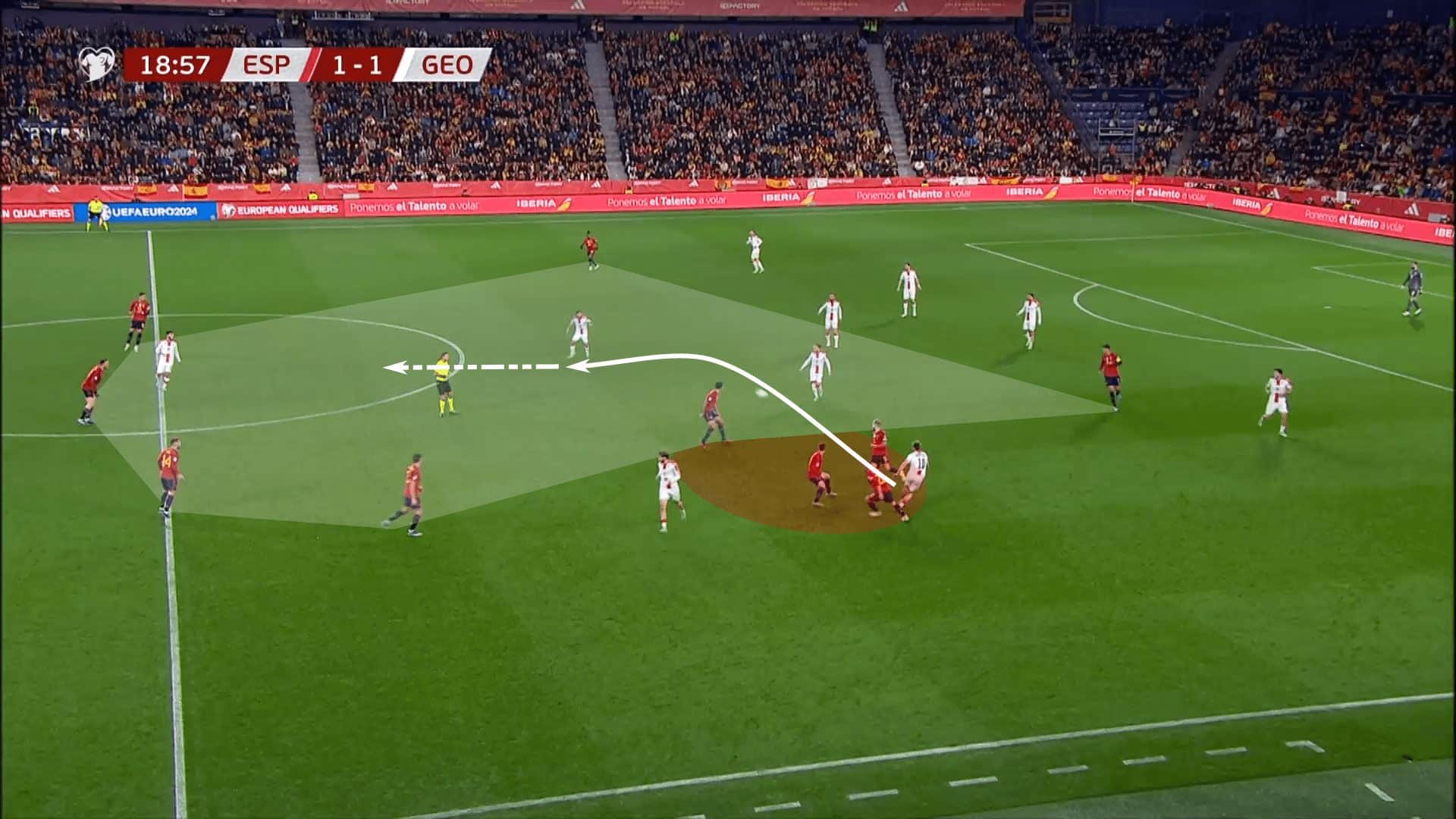
We’ve already touched upon their aggressive rest defence.
Their in-possession tactics push seven or eight players high up the pitch, leaving them exposed elsewhere.
Brazil was able to play Vinícius Júnior into the Spanish half of the pitch.
Look at the size of the gap in the Spanish lines.
This loss of possession could only have gone worse if Vinícius Júnior had scored.
There’s no excuse for an unopposed run into the central channel for one of the best players in the world.
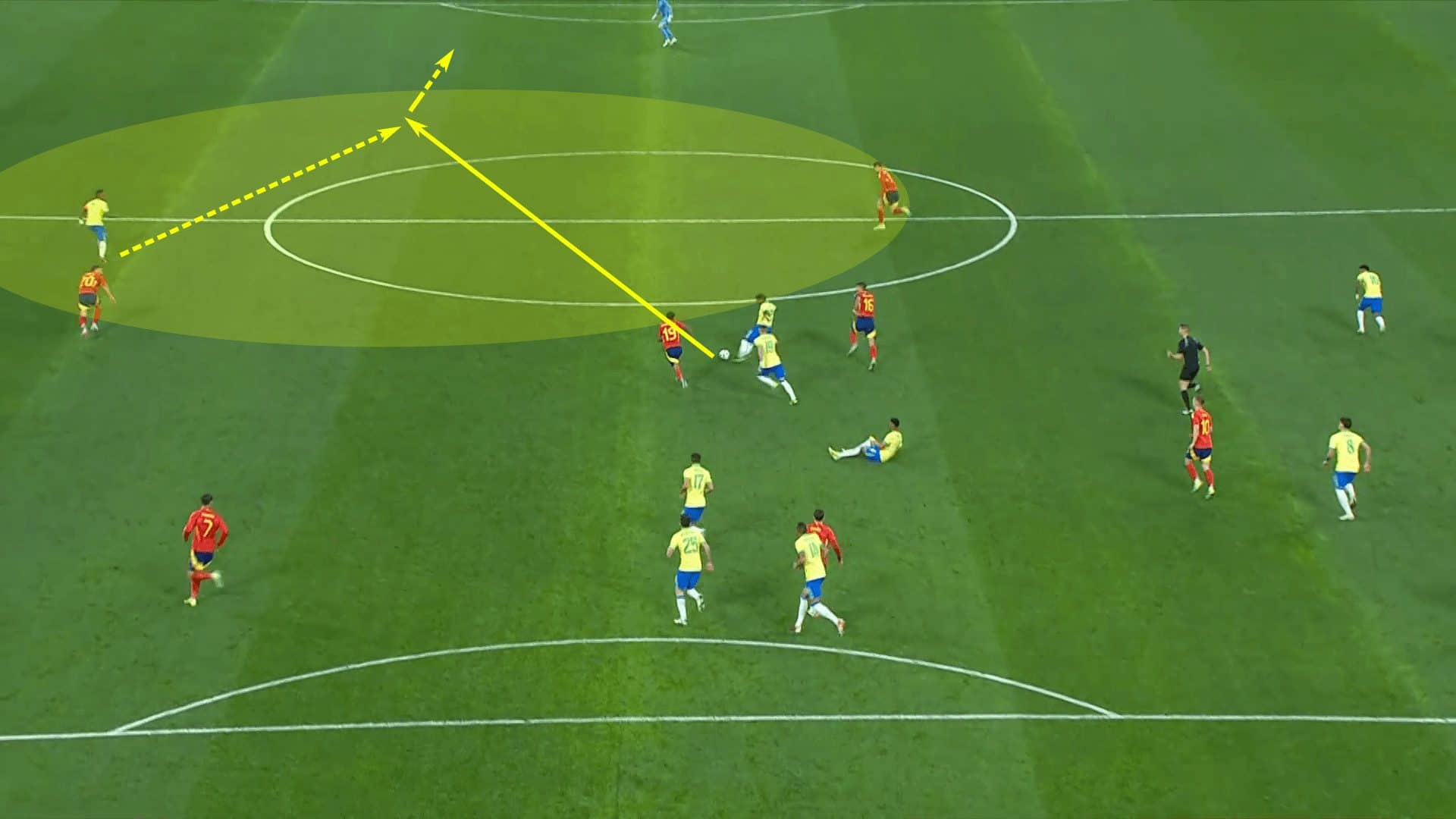
Managing transition, especially their counterpressing, will be critical for the Spanish.
In recent tournaments, when they have lost, the opposition’s ability to create through counterattacks has largely been the cause of Spain’s demise.
The problem hasn’t gotten any better, you could make a case at this phase it has actually gotten worse.
Spain’s defending in transition will weigh heavily on their tournament progression.
Forwards
Spain’s forward line will likely feature journeyman striker Álvaro Morata flanked by the exciting young talents of Nico Williams and Barcelona’s Lamine Yamal.
Joselu is the next #9 off the bench, with Ferran Torres, Ayoze Perez and Mikel Oyarzabal are the likely candidates off the bench to round out Spain’s top line.
Midfielders
Midfield could get interesting.
Rodri will likely see the pitch until the result is a foregone conclusion.
He’ll anchor Spain’s midfield 3.
Look for PSG’s Fabián Ruiz to join him with Dani Olmo as the likeliest player at the 10.
They’ll be supported by Mikel Merino and Martín Zubimendi.
Álex Baena from Villarreal makes the cut as the 22-year-old is one of the more intriguing midfielders in Spain’s player pool.
He’s joined by Barcelona midfielders Pedri and Fermin Lopez, with Aleix Garcia rounding out the group.
Defenders
The defending group will be anchored by Real Madrid‘s Dani Carvajal, long-time starter Aymeric Laporte and the likely presence of Robin Le Normand at centreback.
Left-back is still a little bit of a mystery, but the attacking presence of Álex Grimaldo is very appealing, especially given the season he has had in the Bundesliga with the invincible Bayer Leverkusen team.
At the moment, Marc Cucurella is the likely backup left-back and Jesús Navas will offer relief at right-backs.
Daniel Vivian and Barcelona starlet Pau Cubarsí are remaining the centrebacks to join the group.
At goalkeeper, look for Unai Simón to start with Álex Remiro and David Raya backing him up.
Key player
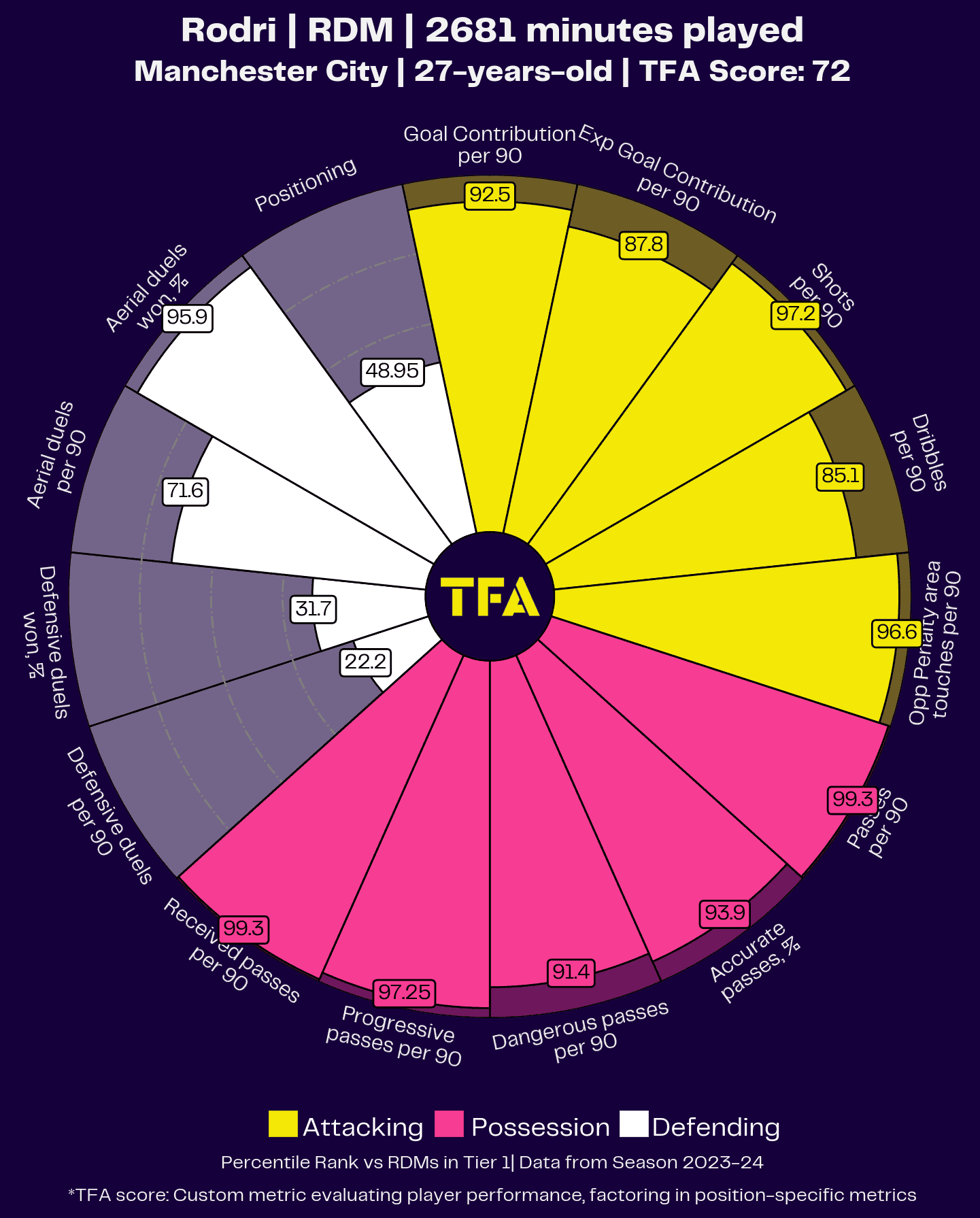
This may be a case where a team’s best player and most important player align.
It’s tough to make a case against Rodri as the most critical component to Spain’s tournament success.
A serial winner, the Manchester City star is the link between lines and the player with the biggest job ahead of him.
Managing defensive transitions will be key for Spain.
It’s Rodri who will be tasked with protecting the centrebacks and ending opposition attacks.
This is perhaps the weakest part of his skill set, but that’s not saying much given how exceptional he is in those other areas.
Rodri’s ability to control the match from the #6 is arguably the most important aspect of Spain’s tournament.
Tournament prediction
Being drawn in the Group of Death certainly complicates Spain’s tournament.
Those matches against the more pragmatic Croatian and Italian teams might be the kryptonite to Spain’s possession.
There’s still an expectation that they top the group, and that is our projection as we head into the tournament, but there’s certainly no guarantee.
Whether they finish first or second in the group (even third is a possibility), a difficult path through the tournament awaits them.
They could just as easily reach the finals or see an early exit in the Round of 16 or quarter-finals.
Avoiding the host nation in the Round of 16 is ideal for the Spanish, but the possibility of a quarter-final matchup against tournament favourites, England, looms.
This is a very good Spanish side, but given the path they’ve drawn through the tournament, a quarterfinal exit would not surprise us.
There may not be another team in the tournament with the bigger discrepancy between their ceiling and floor, their best possibility and their worst possibility, at this tournament.

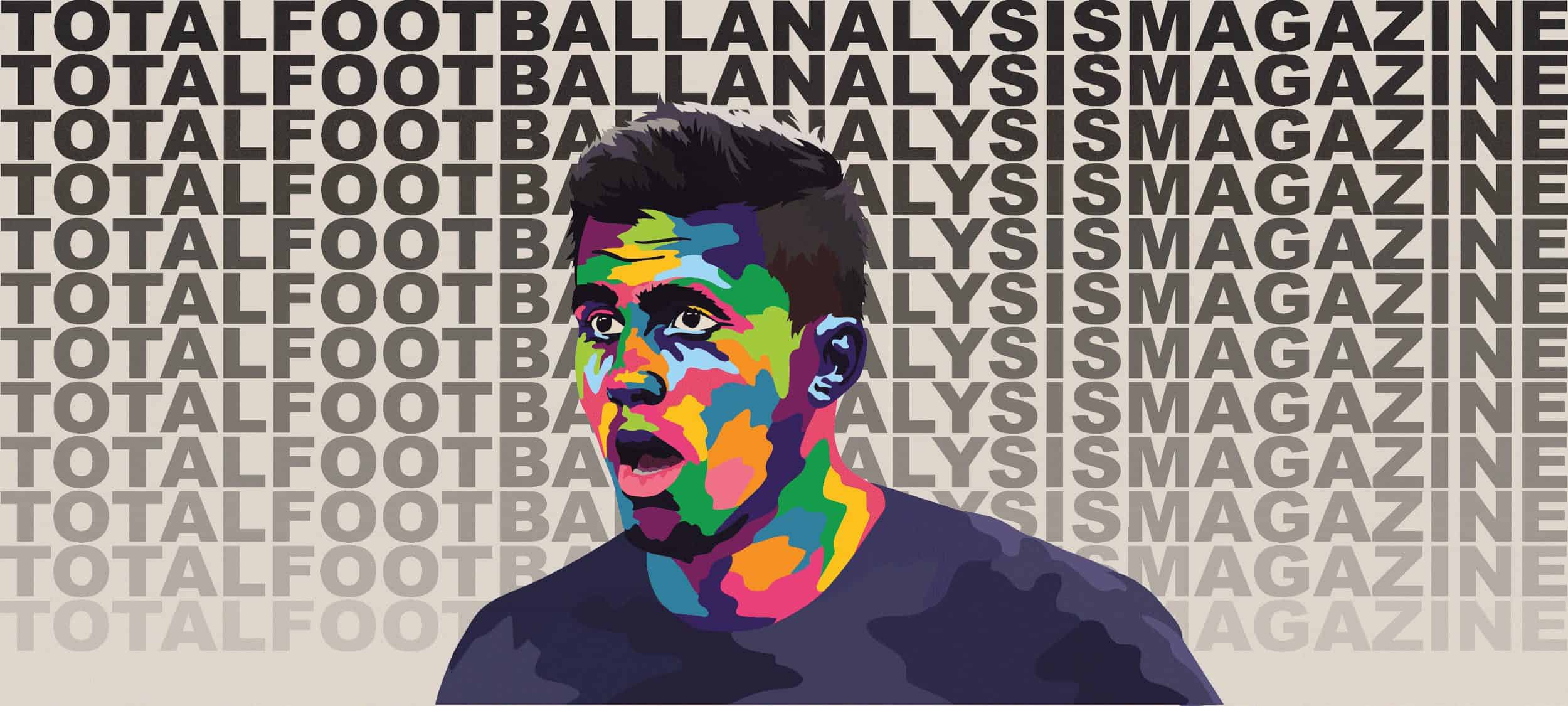



Comments